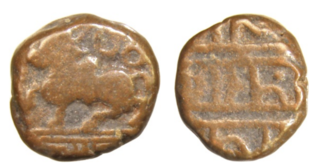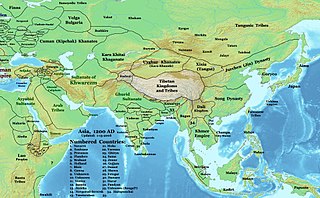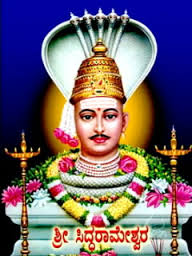Related Research Articles

Lingayatism or Veera Saivism is a Hindu denomination based on Shaivism. Initially known as Veerashaivas, since the 12th-century adherents of this faith are known as Lingayats. The terms Lingayatism and Veerashaivism have been used synonymously, but Lingayathism may refer to the broader Lingayat philosophy which predates Lingayatism, to the historical community now called Lingayats, and to a contemporary (sub)tradition within Lingayatism with Vedic influences.

Basava, also called Basaveshwara and Basavanna, was a 12th-century CE Indian statesman, philosopher, poet, Lingayat social reformer in the Shiva-focussed bhakti movement, and a Hindu Shaivite social reformer during the reign of the Kalyani Chalukya/Kalachuri dynasty. Basava was active during the rule of both dynasties but reached the peak of his influence during the rule of King Bijjala II in Karnataka, India.

Kannada literature is the corpus of written forms of the Kannada language, a member of the Dravidian family spoken mainly in the Indian state of Karnataka and written in the Kannada script.

Veerashaivism is a sect within the Shaivism fold of Hinduism. According to tradition, it was transmitted by Panchacharyas,, or five acharyas: Renukacharya, Darukacharya, Ekorama, Panditharadhya, Vishwaradhya, and first taught by Renukacharya to Agastya, a Vedic seer. The preachings of Jagadguru Renukacharya Bhagavadpada to rishi Agastya is recorded in the form of a book, Shri Siddhantha Shikhamani, which is regarded as an important holy book for the Veerashaivas. This text is likely an 8th century work, and it likely contains the earliest reference to Veerashaivism in literature.
Devanga is a Hindu caste from South India that traditionally followed the occupation of textile merchandise, weaving and farming mostly found in the Indian states of Karnataka, Kerala, Andhra Pradesh, Tamil Nadu and Odisha.

Deva Raya II was an emperor of the Vijayanagara Empire. The greatest of the Sangama dynasty rulers, he was an able administrator, warrior, and scholar. He authored well-known works in the Kannada language and in the Sanskrit language. He was patron to some of the most noted Kannada poets of the medieval period, including Chamarasa and Kumara Vyasa, the Sanskrit poet Gunda Dimdima, and the noted Telugu language poet Srinatha, whom the king honored with the title Kavisarvabhauma. He supported development in secular literature as well as the noted South Indian mathematician Parameshvara, from the Kerala school of astronomy and mathematics lived in his empire.

The Jangam or Jangamaru are a Shaiva order of religious monks. They are the priests (Gurus) of the Hindu Shaiva sect, Gurus of Veerashaiva sect and are disciples of Lord Shiva as mentioned in Basava Puranas. The meaning of word Jangam is 'moving linga'. Jangama is one who is endowed with true spirit of Agamic knowledge, and has sacrificed his life for giving Samskara (good) character building practices in all sections of the Hindu society.

Allamaprabhu was a 12th-century mystic-saint and Vachana poet of the Kannada language, propagating the unitary consciousness of Self and Shiva. Allamaprabhu is one of the celebrated poets and the patron saint of the Lingayata movement that reshaped medieval Karnataka society and popular Kannada literature. He is included among the "Trinity of Lingayathism", along with Basavanna, the founder of the movement, and Akka Mahadevi, the most prominent woman poet.
Channabasavanna also known as " Guru Channabasaveshwara " was Basava's nephew and one of the foremost Sharanas of the 12th century. He, along with Basava, Allama Prabhu and Akka Mahadevi, played a pivotal role in the propagation of the Lingayat faith. He was the youngest among the sharana leaders and grew up in the household of Basavanna as he was the son of Nagalambike, Basava's own sister. He also wrote the Karana Hasuge which is one of the most sacred texts of the Lingayats, among many vachanas. He propounded the "shatasthala" philosophy associated with the six holy places of Veerashaiva Lingayat creed. He succeeded to the Shunya Simhasana at Anubhava Mantapa, Kalyana after the departure of Allama Prabhu, circa 1162ad. His young shoulders carried on the legacy of Basava after the latter's departure to Kudalasangama in 1162ad. He is credited to have systematised the entire manual of simple rituals for the followers. He was a strong advocate of the Ishtalinga wearing and expounded the material as well as the esoteric meaning of that divine symbol. He held together the nascent group of Shivasharanas and Jangmas in tumultuous times of clashes with the orthodox Brahmins and heretic Jains. Following the assassination of Kalachuri King Bijjala II in 1167 A.D, Channabasava along with his followers migrated to Ulavi safeguarding the Vachana literature. He attained Samadhi state there at the age of 25 passing on the leadership of the movement to Siddarama.
In Veerashaiva theology the Panchacharas denote the five codes of conduct to be followed by the devotee. The Panchacharas include

Hoysala literature is the large body of literature in the Kannada and Sanskrit languages produced by the Hoysala Empire (1025–1343) in what is now southern India. The empire was established by Nripa Kama II, came into political prominence during the rule of King Vishnuvardhana (1108–1152), and declined gradually after its defeat by the Khalji dynasty invaders in 1311.
Chamarasa was a 15th century Virashaiva poet in the Kannada language, during the reign of Vijayanagar Empire, a powerful empire in Southern India during 14th - 16th centuries. A contemporary and competitor to a noted Brahmin Kannada poet Kumara Vyasa, Chamarasa was patronised by King Deva Raya II. The work is in 25 chapters (gatis) comprising 1111 six-line verses (arupadi).

Mysore literature in Kannada is a body of literature composed in the Kannada language in the historical Kingdom of Mysore in Southern India and written in the Kannada script. The writings date from the Kingdom of Mysore, which existed from around 1600 CE until the establishment of modern India in 1947. Many of the works of this literature written on religious themes are labeled Veerashaiva or Vaishnava in acknowledgment of the two faiths that gave form to the literature and fostered it until the advent of the modern era. Despite a gradual decline in the popularity of Jainism, authors devoted to the faith produced some works of merit. Secular themes dealing with a wide range of subjects were also written on. Kannada literature flourished for a short while in the court of the neighbouring kingdom of the Nayakas of Keladi whose territory was annexed by Mysore in 1763.
Nijaguna Shivayogi was an Indian poet and a prolific writer in the Kannada language. He lived in the 15th century. He was a follower of the Veerashaiva faith, which he attempted to reconcile with the Advaita Hinduism of Adi Shankaracharya. Tradition has it that Shivayogi was a petty chieftain of Kollegal taluk in modern Mysore district of Karnataka state, India. Considered a visionary of his time, his Vivekachintamani, written in encyclopaedic proportions and in prose style, and the Kaivalya Paddhati, a musical treatise consisting of songs are considered his most enduring works.

Vijayanagara literature in Kannada is the body of literature composed in the Kannada language of South India during the ascendancy of the Vijayanagara Empire which lasted from the 14th through the 16th century. The Vijayanagara empire was established in 1336 by Harihara I and his brother Bukka Raya I. Although it lasted until 1664, its power declined after a major military defeat by the Shahi Sultanates in the battle of Talikota in 1565. The empire is named after its capital city Vijayanagara, whose ruins surround modern Hampi, now a World Heritage Site in Karnataka.

Raghavanka was a noted Kannada writer and a poet in the Hoysala court who flourished in the late 12th to early 13th century. Raghavanka is credited for popularizing the use of the native shatpadi metre in Kannada literature. Harishchandra Kavya, in shatpadi metre, is known to have been written with an interpretation unlike any other on the life of King Harishchandra is well known and is considered one of the important classics of Kannada language. He was a nephew and protégé of the noted Early 12-century Kannada poet Harihara. Although the shatpadi metre tradition existed in Kannada literature prior to Raghavanka, Raghavanka inspired the usage of the flexible metre for generations of poets, both Shaiva and Vaishnava to come.
Andayya was a notable 13th-century Kannada writer during the rule of the Hoysala empire. Andayya was a Jain by faith and came from a family of accountants. His most important extant work is the Kabbigara Kava which also goes by the names Sobagina Suggi, Madana Vijaya or Kavana Gella and was written in the 1217–1235 CE period.

Siddheshwar also known as Siddharameshwar and Siddharama was one among the five acharya ("saint") of the Veerashaiva faith. Siddheshwar was a great contributor to Veerashaiva sampradaya of Hinduism. He was a great mystic and a Kannada poet who was a part of Basavanna's Veerashaiva revolution during the 12th century. His philosophy was one of service to mankind, the path of Shivayoga. Siddarama was instrumental in saving the vachana literature from destruction. Shri Siddharameshwar was born in Solapur City of Maharashtra.
Shirasangi Lingaraj Desai (1861-1906) was an Indian philanthropist and ruler king and last provincial ruler of Shirasangi province. He donated all his property to assist education of Veerashaiva students. He presided the first All India Veerashaiva Mahasabha convention held in 1904 at Dharwad.
Nandeesvarar Temple is a Hindu temple dedicated to the deity Shiva, located at Nandhimalai in Karnataka, India.
References
- ↑ Sivalingayya Channabasavayya Nandimath; Ramendra Nath Nandi (1979). A handbook of Vīraśaivism. p. 16. ISBN 0-89684-053-0.
- ↑ Shankaragouda Hanamantagouda Patil (2002). Community Dominance and Political Modernisation: The Lingayats. p. 20. ISBN 81-7099-867-0.